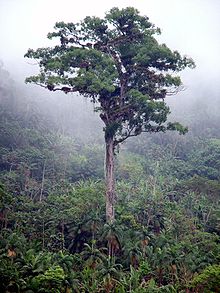| Cariniana legalis | |
|---|---|

| |
| Conservation status | |
 Vulnerable (IUCN 2.3) | |
| Scientific classification | |
| Kingdom: | Plantae |
| Clade: | Tracheophytes |
| Clade: | Angiosperms |
| Clade: | Eudicots |
| Clade: | Asterids |
| Order: | Ericales |
| Family: | Lecythidaceae |
| Genus: | Cariniana |
| Species: | C. legalis |
| Binomial name | |
| Cariniana legalis (Martius) Kuntze | |
Cariniana legalis is a species of emergent rainforest tree in the Monkeypot family Lecythidaceae. It is found in the Atlantic forest of south-eastern Brazil, where is known as jequitibá-branco or jequitibá-rosa, and possibly found in Colombia, and Venezuela. These trees can be very large. A C. legalis measured by botanical explorer David Fairchild was 62 feet (19 meters) in circumference with no buttresses at six feet (two meters) above ground.
One of the biggest trees in the Atlantic Forest, there are some old trees in Santa Rita do Passa Quatro and near Petrópolis. One of these trees is more than 3 000 years old.
It is threatened by habitat loss.
References
- Americas Regional Workshop (1998). "Cariniana legalis". The IUCN Red List of Threatened Species. 1998. Conservation & Sustainable Management of Trees, Costa Rica, November 1996. IUCN: e.T34747A9887065. doi:10.2305/IUCN.UK.1998.RLTS.T34747A9887065.en. Retrieved 20 December 2017.
- Fairchild, David G. (May 1901). "Coffee Growing in Brazil and the Giant Jequitiba Trees". Botanical Gazette. 31 (5): 353–354.
Gallery
-
 Jequitibá-rosa in the Botanical Garden of São Paulo.
Jequitibá-rosa in the Botanical Garden of São Paulo.
-
 Same tree, from another angle.
Same tree, from another angle.
-
 Jequitibá-rosa in the Aclimação Park, São Paulo.
Jequitibá-rosa in the Aclimação Park, São Paulo.
-
 Giant Jequitibá-rosa estimated to be 3000 years old, in the Vassununga State Park, Santa Rita do Passa Quatro.
Giant Jequitibá-rosa estimated to be 3000 years old, in the Vassununga State Park, Santa Rita do Passa Quatro.
-
 Canopy of the same tree in Vassununga State Park.
Canopy of the same tree in Vassununga State Park.
| Taxon identifiers | |
|---|---|
| Cariniana legalis |
|
| Couratari legalis | |
This Lecythidaceae article is a stub. You can help Misplaced Pages by expanding it. |